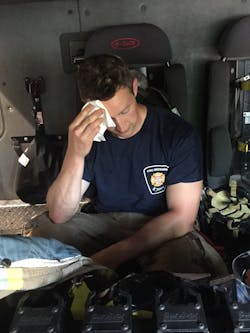It’s understood that firefighters are exposed to a variety of chemicals from combustion emissions during fire suppression. These include organic chemicals (i.e., made up of carbon and hydrogen), such as polycyclic aromatic hydrocarbons (PAHs); inorganic chemicals (i.e., made up of mainly carbon but with other elements as well), such as brominated flame retardants; and metals, such as lead, antimony, cadmium and uranium.
The best way to avoid exposure to these chemicals is to avoid contact. Although manufacturers are working hard to develop protective equipment to do so, the technology cannot yet reduce firefighter exposure to these chemicals to zero. Firefighters will be exposed to these compounds in some capacity. As such, the question remains: What do we do?
There are several products and approaches to decontamination being marketed to address this question. With this in mind, let’s review the current information available from the scientific community so you can make the most informed decisions possible for your health and safety.
Skin-cleaning wipes
A study of wipes found that generic baby wipes removed 54 percent of PAHs,1 some of which are known carcinogens. Further, wipes developed for firefighters are promoted to be superior to baby wipes and other wipe products. Specifically, some wipes use specialized formulas that are said to target fireground hazards as well as a thick, heavy-duty textures that are designed for tougher environments.
To date, two companies have undergone third-party testing of their wipes. One company reports removal rates of up to 69 and 90 percent of two chemicals with known toxicity and presence at fires. Another company reports a removal rate of up to 99 percent for lead as well as other heavy metals, but details of how they tested this are not publically available.2 Testing by other wipe companies is expected in the near future.
The results of testing from wipe companies seem promising, but more research is necessary to answer additional questions:
· Are all wipes able to remove a significant amount of the most worrisome chemicals firefighters are exposed to—and not increase the absorption of it?
· With multiple wipes on the market for firefighters, how does one decide on the best product for their department?
· Are there certain ingredients that will make a significant difference in the efficiency of one wipe over another to remove contaminants?
Work is currently being conducted to answer some of these questions. Researchers out of the University of Ottawa, in collaboration with the Ottawa Fire Services, are currently investigating different decontamination methods. Results from this study are expected by summer 2020.
Saunas
There is no denying that saunas have many health benefits, including improvements in certain respiratory conditions and cardiovascular health.3–5 Several studies have found that healthy lifestyle choices (e.g., sufficient sleep, hydration, well balanced diet, and exercise) coupled with sauna use improved health and sometimes levels of selected chemicals in the body. As such, firefighters have taken to saunas as a way to reduce the amount of chemicals in their body. While this is a logical thought, there are several other considerations to keep in mind.
First, just because a chemical has been measured in sweat does not necessarily mean that sweating is the best method of detoxification. The proportion being removed from your body is important. In fact, it’s been shown that less than 0.02 percent of one’s daily intake of polychlorinated biphenyls (PCBs) can be sweat out.6
No study to date has assessed the ability of a sauna alone to remove toxic chemicals from one’s body. All past studies have used a combination of therapies. It is therefore impossible to distinguish the effect of sauna use and sweating without considering the effects of the other therapies. In fact, one study found sauna use alone did not reduce cardiovascular and all-cause mortality whereas a combination of sauna use and good cardiovascular fitness did reduce this risk.5
Many studies found that reduced body burden of chemicals after sauna use involved the individual avoiding the source of chemical exposure. For example, Sprouse, et al found that when a man stopped going to work where he was being exposed and went through a “detox treatment,” his health improved.7 Was it the “detox treatment” that improved his health or simply the fact that he stopped being exposed? Was time and the body’s natural detoxification system (kidneys and liver) the main reason why the individual’s health improved?
Further, there are concerns with adding an additional heat stress event to a firefighter’s life. Kidneys are a major part of the body’s filtration system, and excess heat has been shown to injure firefighters’ kidneys.8 Therefore, if sweating via sauna is only removing a small portion of a chemical in the body, but injuring the kidneys, it could impede detoxification and, in fact, worsen the situation.
Firefighters are exposed to hundreds of different chemicals. Chemicals can differ significantly in how they enter our bodies, where they are stored, how long they are stored for, and how they are excreted. What may work for one method of detoxification may not work for another.
Overall, at the present time, there is insufficient evidence to support the use of saunas as a means of removing the chemicals firefighters are exposed to from the body. As more data and research emerges, the use of saunas will be re-evaluated.
Be proactive
There is no question that everyone is desperate to find a solution to the staggering rates of cancer within the fire service. And there are products and approaches that may be a step in the right direction. But we must be cautious to not declare any one approach to be the “magic bullet” before further research can address additional questions.
Although chemical exposures do impact cancer rates, we cannot focus solely on this issue without also addressing other issues that play significant roles in the risk of illness and disease. Specifically, absence of excess body fat has been shown to lower the risk of most cancers, yet firefighters have staggering numbers when it comes to weight, with 80 percent of career and 78 percent of volunteer firefighters being overweight or obese.9–10
The bottom line: We cannot lose sight of the basics. Reducing cancer risks in other parts of life (e.g., fitness, diet, smoking habits), limiting chemical exposure by wearing proper PPE and using SCBA from start of fire suppression to end of overhaul, and minimizing cross-contamination must be addressed and fully enforced.
References
1. Fent, K. W. et al. Contamination of firefighter personal protective equipment and skin and the effectiveness of decontamination procedures. J. Occup. Environ. Hyg. 14, 801–814 (2017).
2. Esswein, E. et al. Handwipe method for removing lead from skin. JAI 8, 1–10 (2011).
3. Kunutsor, S. K. et al. Sauna bathing reduces the risk of respiratory diseases: a long-term prospective cohort study. Eur. J. Epidemiol. 32, 1107–1111 (2017).
4. Brunt, V. E. et al. Passive heat therapy improves endothelial function, arterial stiffness and blood pressure in sedentary humans. J. Physiol. 594, 5329–5342 (2016).
5. Kunutsor, S. K. et al. Joint associations of sauna bathing and cardiorespiratory fitness on cardiovascular and all-cause mortality risk: a long-term prospective cohort study. Ann. Med. 50, 139–146 (2018).
6. Imbeault, P. et al. Can POPs be substantially popped out through sweat? Environ. Int. 111, 131–132 (2018).
7. Sprouse, A. et al. Organic solvent-induced bipolar disorder: a case report. Adv Mind Body Med, 27(3), 19-23 (2013).
8. Schlader, Z. J. et al. Firefighter Work Duration Influences the Extent of Acute Kidney Injury. Med. Sci. Sport. Exerc. 49, 1745–1753 (2017).
9. Lauby-Secretan, B. et al. Body Fatness and Cancer — Viewpoint of the IARC Working Group. N. Engl. J. Med. 375, 794–798 (2016).
10. Poston, W. S. C. et al. The Prevalence of Overweight, Obesity, and Substandard Fitness in a Population-Based Firefighter Cohort. J. Occup. Environ. Med. 53, 266–273 (2011).
More from the Cancer Awareness & Prevention supplement:
Download the full Cancer Awareness & Prevention supplement here.
About the Author
Jennifer Keir
Jennifer Keir is a research associate and PhD student at the University of Ottawa studying toxic exposures to combustion-derived substances. She completed her master’s degree in chemical and environmental toxicology at the University of Ottawa where she assessed firefighters’ exposures during on-shift, emergency fire suppression. Keir also has bachelor’s degrees in chemistry and health science from the University of Western Ontario.

